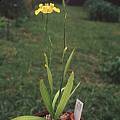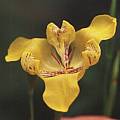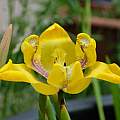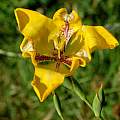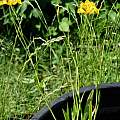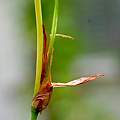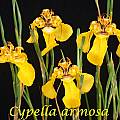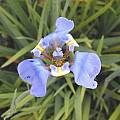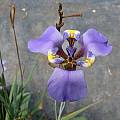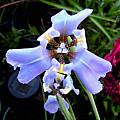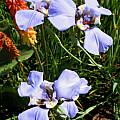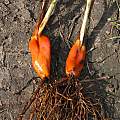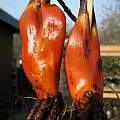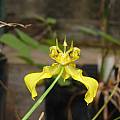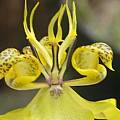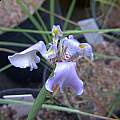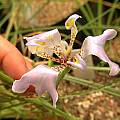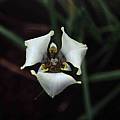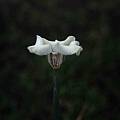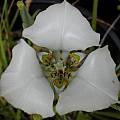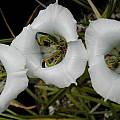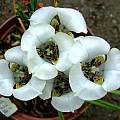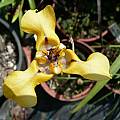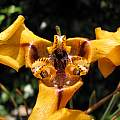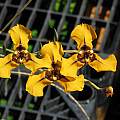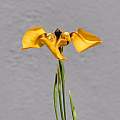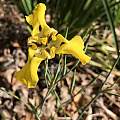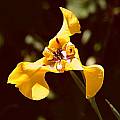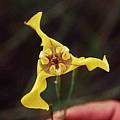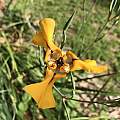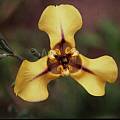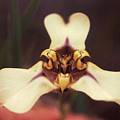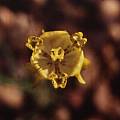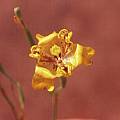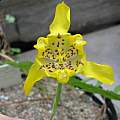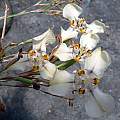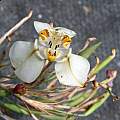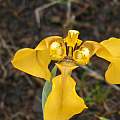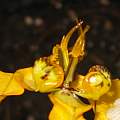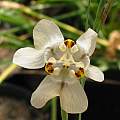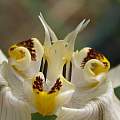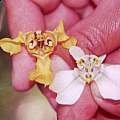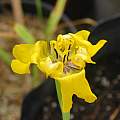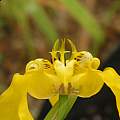Cypella is a genus in the Iridaceae with about 15 species native from Mexico to Argentina. Species in this genus have scaly bulbs and sword-shaped leaves with yellow, blue, or purple flowers. There are species that some consider to be in this genus and others include in the genus Hesperoxiphion.
Cypella aquatilis is found in Brazil in areas periodically inundated. Photos 1 and 2 by Germán Roitman, 3-6 by Martin Bohnet. Photo 6 shows a bulbill which they produce in about every axilla of the flowering stem - one can see the root tip emerging.
Cypella armosa is found in Argentina and Paraguay in areas periodically inundated. Photo by Bill Dijk.
Cypella coelestis (syn. Phalocallis coelestis, Cypella plumbea) is from Brazil, Uruguay, and Argentina. It is probably grown more often than any species in this genus and under many different names. In coastal California, it does very well in the ground as a landscape plant. When there is water in the winter, it does not go completely dormant. In spring, new leaves and buds will appear. Flowers appear throughout summer but each flower lasts only a day. Photo 1 was taken by Bob Rutemoeller and photo 2 by Susan Hayek for Diana Chapman. Photo 3 was taken August 2003 by Lee Poulsen of his plant which he received named as Cypella plumbea platensis. Photo 4 was taken at the end of June 2005 by Merrill Jensen at the Elizabeth F. Gamble Garden, Palo Alto, California. Photos 5-6 were taken by Nhu Nguyen showing the bulbs. The bulb scales are richly colored burnt-orange and are much more delicate than they appear.
Cypella exilis is from Argentina where it grows in grasslands, flowering in summer. Similar to Cypella armosa, the flowers are pale yellow and are found in more western places than Cypella armosa. It's possible that they are both the same species. Photos by Germán Roitman.
Cypella hauthalii is native to Argentina. There are two subspecies. Plants are winter growers native to grassland with semi-shaded conditions (Rogan Roth).
Cypella hauthalii ssp. hauthalii is from Argentina. Plants have very short stems and grow in grasslands. They flower in spring. The flowers are bigger, more open, and violet as compared to spp. opalina. Photos by Germán Roitman.
Cypella hauthalii ssp. opalina is from Argentina. Plants have very short stems and grow in grasslands. They flower in spring. Photos 1-2 were taken by Germán Roitman, 3-4 by Dirk Wallace, and 5 by Rogan Roth.
Cypella herbertii (Lindl.) Herb. is native to Argentina and Uruguay and is the most widespread and common species of Cypella. Plants grow from 50 cm to 1.2 m tall in grasslands and hills. There are 4 recognized subspecies. This species is one of the most easy to grow and rewarding of South American irids. If well grown, it can flower for several months continuously. Grow the plants in a well-draining mix (about 1:1 organic:inorganic). They do well in a US one gallon pot (~3L). Keep the soil moist during the summer growing season and dryish in winter. Fertilize occasionally during active growth. In the winter, the plant will go dormant if water is withheld. In the San Francisco Bay Area, plants grown outdoors that get winter rain will stop growing but will not go completely dormant. When the weather warms up, new leaves and buds will appear.
This plant is easily grown from seeds. Sow the seeds in the same mix as above in spring, taking care not to overcrowd the pot. Seeds can be sown in a smaller pot and then carefully unpot the plants without disrupting the soil and place into a one gallon pot. Conversely, seeds can be sown directly into a one gallon pot. The most vigorous seedlings will flower in the first year. Photo 1 was taken by Alessandro Marinello. Photos 2-3 were taken by Nhu Nguyen. The last photo is from Wylie Young.
Cypella herbertii ssp. brevicristata Ravenna is the more common subspecies with yellow or orange flowers. Its distribution is Brazil (Rio Grande do Sul) to Uruguay. The stigma lobes are short. The first photo was taken by Nicholas Plummer who writes that the subspecies are distinguished by the length of the stigma lobes, but the two forms that he grows also differ in their color with this subspecies having clear yellow flowers. The second photo is from Lee Poulsen who thinks that his plants belong to this subspecies. The last photo from Germán Roitman.
Cypella herbertii ssp. herbertii has a native range is from S. Brazil to NE. Argentina. It has yellow or orange flowers. The stigma lobes are long. The first photo by Nicholas Plummer and the second by Germán Roitman.
Cypella herbertii subsp. reflexa Ravenna is native to Argentina (Entre Ríos).
Cypella herbertii ssp. wolffhuegeli (Hauman) Ravenna has a very restricted distribution in Argentina (Buenos Aires). It has pale yellow flowers. The style branches are free in the upper part. Photo by Germán Roitman.
Cypella laeta is from Argentina and recently sighted in Uruguay. Plants grow in well drained grasslands and flower in spring. Cypella laeta, Cypella aquatilis and Cypella laxa belong to the same subgenus (Nais). Photos by Germán Roitman.
Cypella laxa is from Brazil and Paraguay and recently sighted in Argentina. Plants grow in bog areas and flower in summer. Photo by Germán Roitman.
Cypella osteniana is native to Brazil, Uruguay and Argentina. Photos by Susan Hayek for Diana Chapman.
Cypella osteniana ssp. aurantiaca is native to Brazil, east of Uruguay and Argentina. The flowers are orange and the stigma lobes are concrescent (Bol Soc Argent Bot 38:33-339, 2004). Photos by Germán Roitman.
Cypella osteniana subsp. osteniana is native to west of Uruguay. Plants flower in spring. Flowers are white with divergent stigmas lobes. Photo by Germán Roitman.
Here you can see both subspecies together:
Cypella pabstiana is native to Brazil and recently found in Argentina growing in wet grasslands. Plants flower in spring. Photos by Germán Roitman.
Cypella peruviana see Hesperoxiphion peruvianum
